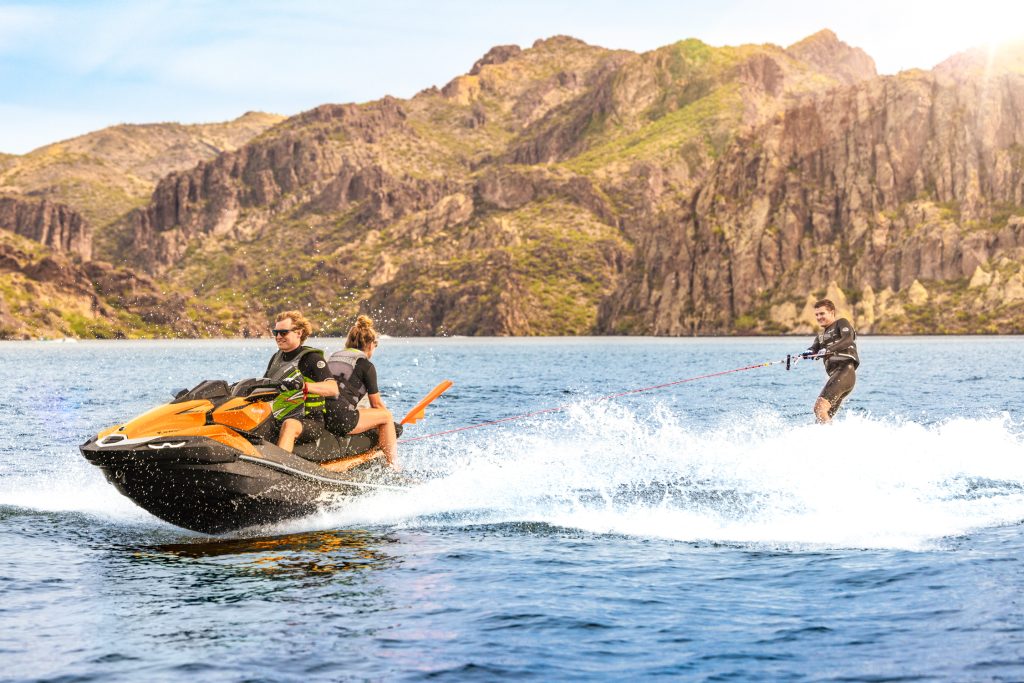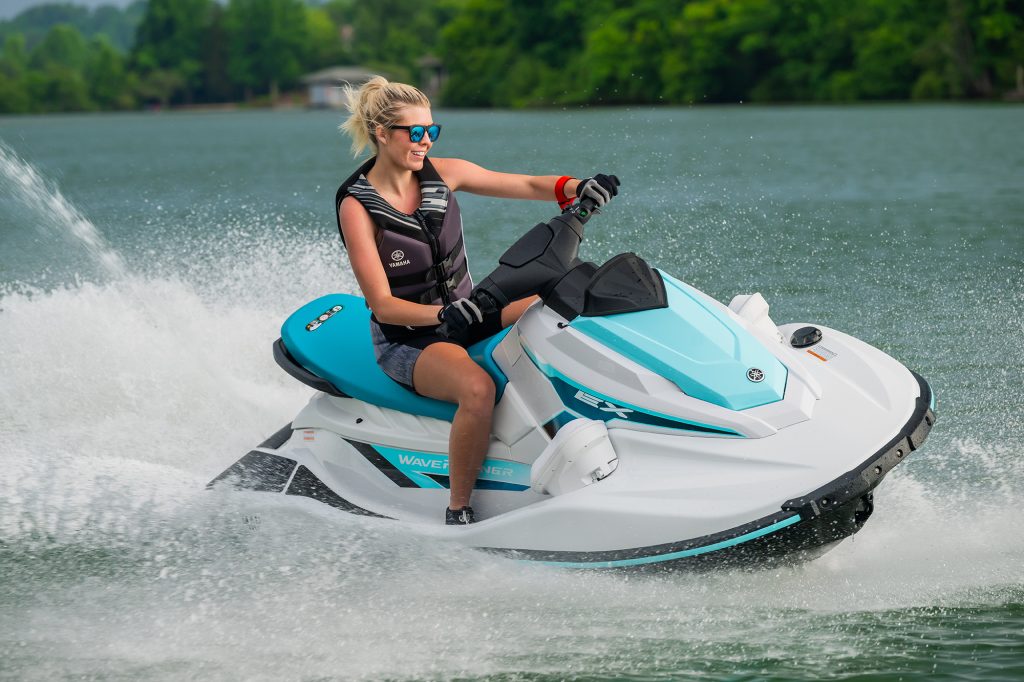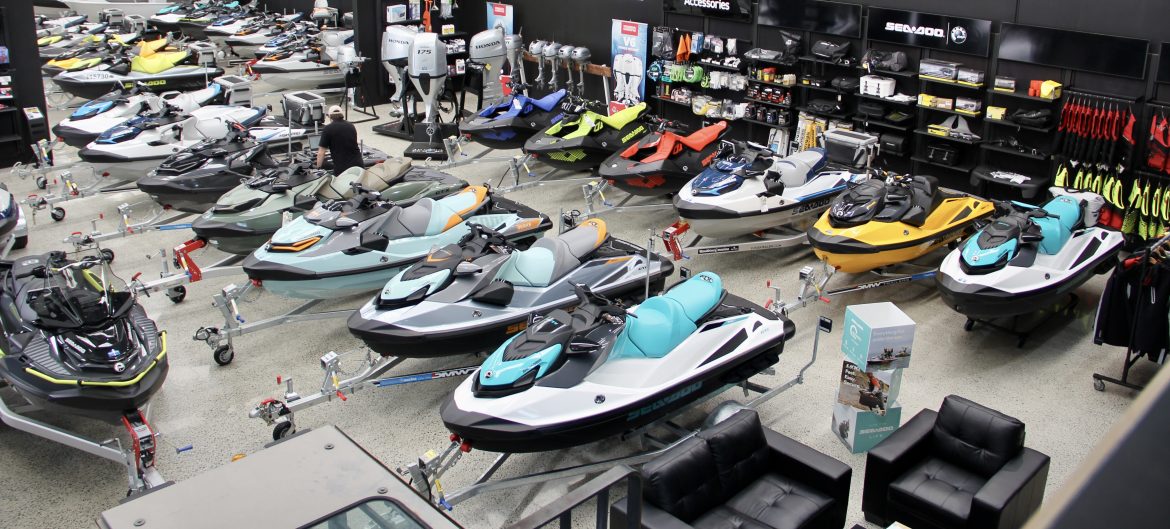Owners and users of personal watercraft (PWCs) have discovered they PWC can enjoy almost any boating activity on these little boats, except perhaps sleeping on board. A PWC can be used to day-cruise or even tour over fairly long distances, if you stay in shoreside accommodations at your destinations.
Many PWCs have enough power to tow a wakeboarder or a tube. With accessories, they can be set up to be a very capable fishing craft and because they draw very little water they’re nimble enough to explore shallow bays and crevasses. A PWC is easy to tow and launch without an expensive heavy-duty tow vehicle, so they’re perfect for boaters who like to roam and explore new waterways on our coasts and lakes. For those feeling competitive, there are active national and regional race series for personal watercraft, although to be competitive you need a performance enhanced machine.

Ownership Costs of Personal Watercraft (PWC)
Personal watercraft prices range from less than $13,000 for compact, two-passenger model to more than $30,000 for the most powerful, luxurious and feature-laden three-passenger models. Most owners use a PWC trailer for off-season storage and moving the craft to and from the water, and the trailer is sold separately from the craft. Expect to pay about $3,000 for a basic single-craft trailer to $9,000 for a trailer that can carry two PWCs. If you anticipate using the PWC in saltwater, invest in a galvanized or aluminium trailer rather than painted steel—it will last much longer. Speaking of trailers, before making a purchase make sure your vehicle has a tow rating that can handle the weight of the boat and trailer you are considering. (Unless you have a smart car, odds are your vehicle can handle the towing.) When considering PWC price don’t forget the basic items you’ll need to get out on the water, including dock lines, life jackets and other safety gear required in your area. PWCs are relatively affordable, but be sure they fit within your unique budget. High-performance, high-tech models with seats for three are naturally on the upper end of the scale, but if you intend to ride on your own, you can save money by buying a smaller model with less bling.
Maintenance Costs
Compared to conventional boats, PWCs require minimal maintenance; an annual oil change and possibly off-season storage prep is about it for most owners. You’ll want a quality tight-fitting cover if your PWC will be stored outside. PWCs are self-draining so do not require an extensive off-season storage procedure, garaging is always a better option for security and protection from the elements. As with any boat, the key operation cost for any PWC is going to be fuel, and that cost will be influenced by how you use the craft and its size and power. A more-powerful PWC will naturally use more fuel, and if you enjoy hard acceleration and faster speed or usually ride with three aboard, you’ll also use more fuel. Some PWC now have an “eco” mode that electronically reduces performance and can dramatically improve fuel economy. In general, though, fuel costs will be much less than for larger boats. Other operational costs include annual registration, insurance and trailer registration and off-season storage if you can’t or don’t care to store the craft at home. Owners who live on or near the water might consider investing in a PWC lift or docking ramp that stores the boat out of the water but also makes it easy to launch when it’s time to ride. Many marinas now have boat storage in the form of Boat stacks, where with one phone call you can have your boat lifted and placed on the water ready to go. Personal Watercraft Technology/Materials/Features Personal watercraft are offered in two basic styles: sit-down and stand-up models. Sit-down models have a seat for one to three passengers. Stand-up models have no seat and represent the origins of the sport, which was really kick-started in the 1970s. Those original stand-up models required a lot of athletic ability to ride well, but today’s stand-up models are wider and longer and much easier to ride. It’s still more challenging than a sit-down PWC, and for some riders much more entertaining just because it’s a bit of a challenge. Some models, powered with a 1498 cc engine producing over 950 lbs of thrust and a weight of just 550 lbs, the acceleration is impressive. Sit-down models range from “rec-lite” models with seating for two, a 90-horsepower engine and a top speed of over 70 kph (45 mph) to the other extreme of a three-passenger luxury model with over 300 horsepower and a top speed of over 100kph (70 mph). The most-deluxe models may feature deep-bolstered touring seats, GPS-based navigation, an audio system and electronic cruise controls that make it easier to tow tubers and skiers. Some models come equipped specifically for tow sports, with a towing pylon and accommodations for a rear-facing “observer” passenger. Others are rigged for anglers, with rod holders and a fishfinder. All current personal watercraft engines are smooth-and-quiet four-stroke motors, which drive a jet pump that propels the craft with a high-pressure jet of water instead of the propeller. Because the jet outlet is above the bottom of the hull, a PWC may draw just inches of water at speed, so it’s able to zip over shallows and is easy to beach. The absence of a prop also makes PWCs safer for tow sports. The most powerful, high-performance PWC models are capable of lightning- quick acceleration and top speeds exceeding 100 kph (70 mph) – a performance that demands respect from the rider and requires awareness on the water. These models may not be a good choice for beginners or younger riders, in saying that, many units have a “learning mode” that dials back the performance. The best personal watercraft is one that fits the way you want to ride—short, quick blasts around the lake, towing tubers all afternoon, fishing and exploring or long-distance touring. There’s a PWC model equipped for any activity.

Safety Tips
Though PWCs are not inherently dangerous, they are involved in a high percentage of reported boating accidents every year.
Here are some safety tips to review if you’re new to riding:
- Children under the age of 16 should not operate a PWC without an adult on board.
- Complete a Coastguard Day skipper course – it will offer confidence and as a result make yours (and your families) time on the water more enjoyable.
- Always have a life jacket (or personal flotation device) onboard for the pilot and each crew member. Make sure that your life jacket and your passenger’s life jackets fit properly and support your individual weights.
- Never mix PWCs and alcohol.
- When driving a PWC with a passenger, make sure your passenger is ready to go before you start.
- When riding a PWC when someone else is driving, make sure that you are holding on tightly. Inform the driver if your hands slip or if you are not ready to go.
- Never start your engine without attaching the kill switch cord (that is connected to the start/stop switch or your key), to your life jacket or wrist. If you fall off, the machine will automatically stop.
- Always watch for bad weather conditions.
- Operate slowly in crowded waterways or anywhere you’re uncertain of traffic rules.
- Keep hands, feet, hair and clothing away from the pump intake.
- Avoid operating in water that’s less than 24″ (60.96 cm) deep.
- Know your water landscape and potential dangers below.
Safety Equipment
Safety equipment is essential, especially being so exposed to the elements, so you will need to be prepared for all eventualities.
Some suggested equipment include:
- Cell phone (fully charged) in a dry bag or case
- Handheld, Floating, High Wattage VHF
- Personal Locator Beacon (if going out wide)
- First Aid Kit
- Tow rope
- Emergency Anchor
- Drinking Water
- Eyewear or Goggles
- Sharkskin Thermal Clothing in colder seasons
- Footwear
- Wet Weather Gear if out in the elements
- Sunscreen




